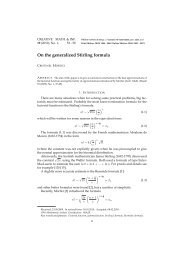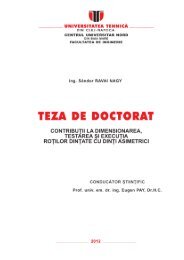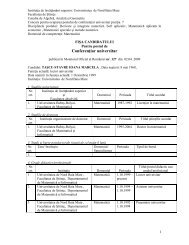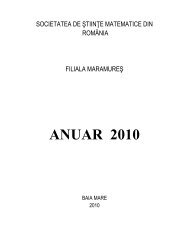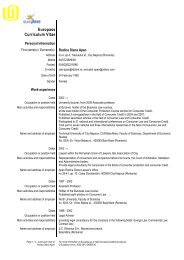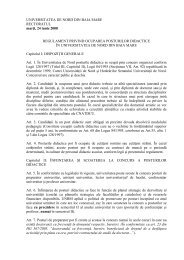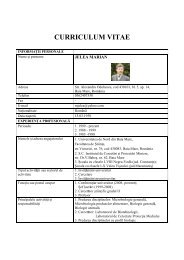The SOR method for infinite systems of linear equations (III)
The SOR method for infinite systems of linear equations (III)
The SOR method for infinite systems of linear equations (III)
Create successful ePaper yourself
Turn your PDF publications into a flip-book with our unique Google optimized e-Paper software.
<strong>The</strong> <strong>SOR</strong> <strong>method</strong> <strong>for</strong> <strong>infinite</strong> <strong>systems</strong> <strong>of</strong> <strong>linear</strong> <strong>equations</strong> (<strong>III</strong>) 514. THE MATRIX NORM SUBORDINATED TO A GIVEN VECTOR NORMFor every x ∈ l 1 and A ∈ M 1 we have ‖Ax‖ 1 ≤‖A‖ 1 ·‖x‖ 1 according to<strong>The</strong>orem 3.1. If x ≠ θ l 1 (the null element <strong>of</strong> the vector space l 1 ), then ‖Ax‖ 1≤{ }‖x‖ 1‖Ax‖1‖A‖ 1 and we can define sup | x ∈ l 1 \{θ l 1} .‖x‖ 1It is known that this <strong>for</strong>mula defines a matrix norm on M 1 , which we call thematrix norm subordinated { to the vector norm } ‖·‖ 1 defined on l 1 and we denoteit by ‖A‖ ∗ ‖Ax‖11 =sup | x ∈ l 1 \{θ l 1} . It is immediately that ‖A‖ ∗ 1 ≤‖A‖ 1 ,‖x‖ 1<strong>for</strong> every A ∈ M 1 . Actually, we have<strong>The</strong>orem 4.2. ‖A‖ ∗ 1 = ‖A‖ 1.∞∑Pro<strong>of</strong>. We must prove that ‖A‖ ∗ 1 ≥‖A‖ 1 . From ‖A‖ 1 =sup |a ij | we obtain: <strong>for</strong>j∈Ni=0∞∑every ε>0 there exists j 0 ∈ N such that |a ij0 |≥‖A‖ 1 − ε. Let us choose thevector x ∈ l 1 such that all the components <strong>of</strong> x are zero except <strong>for</strong> the componentj 0 . So∣ ∣∣∣∣∣ ∞∑∞∑∞∑‖A · x‖ 1 =a ij x j = |a ij0 x j0 | =i=0 ∣j=0i=0(∞∑∞)∑= |a ij0 |·|x j0 | = |a ij0 | ·|x j0 |≥Consequentlyi=0i=0i=0≥ (‖A‖ 1 − ε) ·|x j0 | =(‖A‖ 1 − ε) ·‖x‖ 1 .‖Ax‖ 1≥‖A‖ 1 − ε,‖x‖ 1i.e.{ }‖A‖ ∗ ‖Ax‖11 =sup | x ∈ l 1 \{θ l 1} ≥‖A‖ 1 − ε,‖x‖ 1<strong>for</strong> every ε>0. This means that ‖A‖ ∗ 1 ≥‖A‖ 1.□Corollary 4.3. If <strong>for</strong> the matrix A =(a ij ) i,j∈N we have a ij =0<strong>for</strong> i>nand j>n,n ∈ N, then from <strong>The</strong>orem 4.2 we reobtain the results in the finite dimensional space R n[1], [5].For this paragraph see also [2], [6], [8].<strong>The</strong> above presented vector and matrix spaces will be used to extend the iterativeJacobi’s and Gauss-Seidel’s <strong>method</strong>s, from finite <strong>linear</strong> <strong>systems</strong> to the case<strong>of</strong> <strong>infinite</strong> <strong>systems</strong>. In this way we can study the <strong>linear</strong> stationary processes with<strong>infinite</strong> but countable number <strong>of</strong> parameters.




